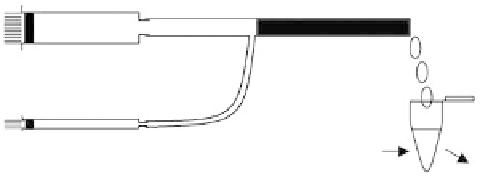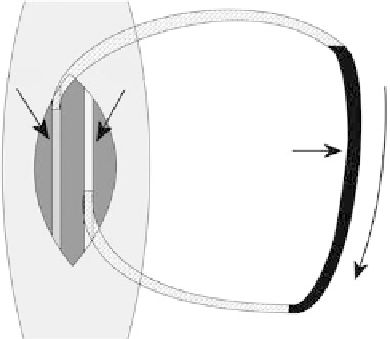Biomedical Engineering Reference
In-Depth Information
Citrated whole blood
Test surface
CaCl
2
EDTA
(Thrombin)
Complement
platelets
FIGURE 17.15
In vitro
setup for dynamic testing of blood compatibility on a synthetic test surface.
Anticoagulated blood (citrated) is recalcifi ed and pumped over the test surface. Blood samples are analyzed
for the desired parameters.
Shunt tubing
Vein
Artery
Test surface
FIGURE 17.16
Ex vivo
shunt model for blood compatibility testing.
Another way to test blood compatibility is to use an
ex-vivo
shunt model (Figure 17.16). This
means that a bypass is connected to a major artery and vein of a test animal or a human volunteer,
and the blood is guided over the test surface (which is at the inside of the tube).
In this way relevant fl ow regimes as well as possible variations in the blood are studied, for
instance, as a result of medication. This sort of experiment is always prone to some form of risk,
especially for embolization or severe clotting. Also the activation of the complement system can
provoke unwanted reactions downstream the conduit in the body.
17.7.2 P
LATELET
A
DHESION
AND
A
CTIVATION
Platelets play a vital role in coagulation and therefore their interaction with blood-contacting
devices is a valuable tool to study blood compatibility.
5,106
Upon adhesion of platelets, these become
activated and subsequently a procoagulant surface is created. This means that the outer surface of
the platelets will catalyze the generation of thrombin and thus result in thrombus formation on the
device.
48
There are several ways to determine the interaction of platelets with synthetic surfaces.
17.7.2.1
Determination of Platelet Adhesion
Adhered platelets can be fi xed on the surface of the device and subsequently studied by microscopy.
Phase contrast microscopy can be used to count the amount of adhered platelets per area, but the



